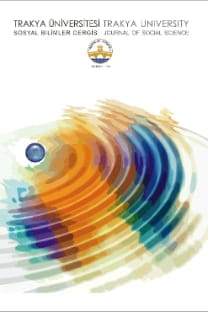AN OBJECT RELATIONS PERSPECTIVE ON IAN McEWAN’S ATONEMENT: BRIONY’S CREATIVE APPERCEPTION IN LIGHT OF ATTACHMENT THEORY GENRE, AND NARRATIVE FORM
Atonement, Nesne ilişkisi, Yaratıcılık, Bildungsroman
AN OBJECT RELATIONS PERSPECTIVE ON IAN McEWAN’S ATONEMENT: BRIONY’S CREATIVE APPERCEPTION IN LIGHT OF ATTACHMENT THEORY GENRE, AND NARRATIVE FORM
Atonement, Object relations, Creativity, Bildungsroman,
___
- Bakhtin, Mikhail. (1986). “The Bildungsroman and Its Significance in the History of Realism (Toward a Historical Typology of the Novel)”. Speech Genres and Other Late Essays. Austin, University of Texas Press. 1986. Bernikow, Louise. Among Women. New York. 1981.
- Blanchot, Maurice. The Writing of the Disaster. Trans. Ann Smock. Lincoln, University of Nebraska Press. 1995.
- Boes, Tobias. “Modernist Studies and the Bildungsroman: A Historical Survey of Critical Trends”. Literature Compass. Vol. 3, no. 2, 2006, pp. 230-243. JSTOR.
- Buckley, Jerome Hamilton. Season of Youth: The Bildungsroman from Dickens to Golding. Harvard University Press. 1974.
- Childs, Peter (ed.). The Fiction of Ian McEwan: A Reader’s Guide to Essential Criticism. Palgrave Macmillan. 2006.
- Chodorow, Nancy. The Reproduction of Mothering: Psychoanalysis and the Sociology of Gender. University of California Press. 1999. D'angelo, Kathleen. “‘To Make a Novel’: The Construction of a Critical Reardership in Ian McEwan’s ‘Atonement’” Studies in the Novel, vol. 41, no. 1, 2009, pp. 88–105. JSTOR.
- Dilthey, Wilhelm. Poetry and Experience. Princeton University Press. 1985.
- Doane, Janice L. and Devon L. Hodges. From Klein to Kristeva: Psychoanalytic Feminism and the Search for the “Good Enough” Mother. The University of Michigan Press. 1992.
- Dobrogoszcz, Tomosz. “Narrative as Expiative Fantasy in Ian McEwan’s Atonement”. Roczniki Humanistyczne, vol. 63, no. 5, 2015, pp.115-127.
- Donald, James and Ali Rattansi (eds.). Race, Culture and Difference. London: Sage. 1992.
- Engel, Manfred. “Varians of the Romantic Bildungsroman in Romantic Prose Fiction”. Ed. By Gerald Gillespie, Manfred Engel and Bernard Dieterle. Romantic Prose Fiction. John Benjamins Publishing Company. 2008.
- Finney, Brian. “Briony's Stand against Oblivion: The Making of Fiction in Ian McEwan's ‘Atonement.’” Journal of Modern Literature, vol. 27, no. 3, 2004, pp. 68–82. JSTOR
- Giles, Jeff. “Luminous Novel from Dark Master.” Newsweek 18 March 2002: 62-63.
- Groes, Sebastian. Ian McEwan: Contemporary Critical Perspectives. Continuum. 2009.
- Hirsch, Marianne. The Mother/Daughter Plot: Narrative, Psychoanalysis, Feminism. Indiana University Press. 1989.
- O'Hara, David K. "Briony's Being-For: Metafictional Narrative Ethics in Ian McEwan's Atonement ." Critique 52 (2011): 74-10.
- Irigaray, Luce. This Sex which is No One, trans. Catherine Porter with Carolyn Burke. Ithaca, Cornell University Press. 1985.
- Kontje, Todd. The German Bildungsroman: History of a National Genre. Colombia. Camden House, 1993.
- Luckas, George. The Theory of Novel. MIT Press. 1974.
- Levin, Amy K. The Suppressed Sister: A Relationship in Novels by Nineteenth- and Twentieth Century British Women. London and Toronto: Associated University Presses. 1992.
- Martin Jacob. “Who Killed Robbie and Cecilia? Reading and Misreading Ian McEwan's Atonement.” Critique: Studies in Contemporary Fiction, vol. 52, no. 1, 2011, pp. 55-73.
- Mathews, Peter. “The Impression of a Deeper Darkness: Ian McEwan’s Atonement.” ESC: English Studies in Canada, vol. 32 no. 1, 2006, pp. 147-160. Project MUSE.
- McEwan, Ian. Atonement. Anchor Books, 2001.
- McNaron, Toni A. H. The Sister Bond: A Feminist View of a Timeless Connection. Oxford: Pergamon Press, 1985.
- Miller, J. Hillis. “Some Versions of Romance Trauma as Generated by Realist Detail in Ian Mc Ewan’s Atonement”. Ganteau, Jean-Michel and Sısana Onega (eds.). Trauma and Romance in Contemporary British Literature. Routledge, 2013.
- Noakes, Jonathan, and Margaret Reynolds. Ian McEwan: The Child in Time, Enduring Love, Atonement. London: Vintage, 2002.
- O’Dwyer, Erin. “Of Letters, Love, and Lack: A Lacanian Analysis of Ian McEwan’s Epistolary Novel Atonement”. Critique: Studies in Contemporary Fiction, 2016. 57:2, 178-190.
- O’Hara, David K. “Briony's Being-For: Metafictional Narrative Ethics in Ian McEwan's Atonement. Critique: Studies in Contemporary Fiction, 2010. 52:1, pp. 74-100.
- Winnicott, Donald. Playing and Reality. Routledge, 2005.
- ISSN: 1305-7766
- Yayın Aralığı: 2
- Başlangıç: 2000
- Yayıncı: Trakya Üniversitesi Sosyal Bilimler Enstitüsü
QUALITATIVE RESEARCH: THE PRE-SERVICE EFL TEACHERS’ OPINIONS ON TEACHING PRACTICIUM
Dilek TÜFEKÇİ CAN, Mehmet BAŞTÜRK
İMALAT İŞLETMELERİNDE YENİ ÜRÜN GELİŞTİRME KRİTERLERİ: KARADENİZ BÖLGESİ ÖRNEĞİ
ARİF’İN NÜSHA-İ ÂLEM MESNEVİSİNDE ÂLEM-İNSAN İLİŞKİSİ
BAROK DÖNEM MÜZİĞİ VE BAROK DÖNEMDE OBUA
FARKLI VARYANSLIK VE YAPISAL KIRILMALAR ALTINDA EKONOMİK BÜYÜME İLE TURİZM İLİŞKİSİNİN İNCELENMESİ
Berhan ÇOBAN, Esin FİRUZAN, Adil OĞUZHAN
ÖĞRETMEN ADAYLARININ TARTIŞMA BECERİLERİ İLE İLETİŞİM BECERİLERİ ARASINDAKİ İLİŞKİNİN İNCELENMESİ
